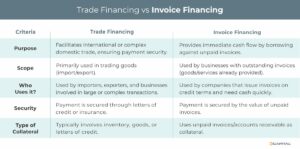
Choosing Between Trade Financing and Invoice Financing to Optimise Cash Flow in a Low-Growth Economy
Content
After a strong start to the year, the UK economy is expected to slow in the second half of 2024, with GDP growth projected to reach just 1%. This may rise slightly to 1.2% in 2025, supported by a slight easing of interest rates and increased consumer spending. Loosening monetary policies and improved real wages could boost consumption and business investment. Still, all indications point to a sustained period of low to moderate growth over the near future. In a low-growth economy, companies need a flexible financial structure to enhance agility and rapid response to new business opportunities when they arise.
Cash flow management becomes crucial for businesses pursuing growth, as revenues often lag operational expenses, payroll, and overheads. Many small and medium-sized enterprises (SMEs) turn to independent funders for fast, flexible financing to address this. Trade financing and invoice financing are common funding solutions, each serving distinct purposes.
Trade financing is ideal for large transactions and long payment cycles, often used in cross-border trade. While it mitigates risks, trade financing can be complex, costly, and less flexible. On the other hand, invoice financing offers quick, easy access to cash with minimal documentation. It is more accessible, features minimal loan (facility) covenants to enhance flexibility, and provides faster liquidity without the need for extensive collateral.
In this article, we explore the differences between trade financing and invoice financing. Keep reading to help your company choose the best financing solution to maintain financial stability while optimising cash flow. Learn whether trade financing or invoice financing is best for your company to support growth as the economy grapples to gain momentum.
Overcoming the cash flow challenges of a low-growth economy
Pursuing growth in a low-growth economy increases cash flow challenges as operational costs, payroll, and overhead expenses rise while revenues lag. Increased competition and tighter margins push businesses to cut prices and costs, which may harm long-term growth. Longer payment terms and customer delays worsen the situation. Businesses must focus on cost management, operational efficiencies, and strong customer relationships to stay sustainable and protect profits.
However, more progressive companies focus on an additional strategy. Many forward-thinking enterprises explore alternative financing options to stabilise financial structures and provide the agility to capitalise on growth opportunities when they arise. These agile companies pursue growth by optimising cash flow efficiency and increasing access to credit, while competing companies struggle to avoid insolvency.
Pursuing growth in challenging economic times offers several advantages, such as improved profit margins, higher employee engagement, and increased market share. Companies that leverage flexible financing options, such as trade financing and invoice financing can maintain momentum despite these challenges. The ability to grow despite delayed payment cycles becomes a key competitive advantage.
Utilizing flexible financing options
Slower sales, rising operational costs, and underperforming business metrics all contribute to increased difficulty in acquiring conventional business financing. As traditional lenders become less tolerant to risk in this environment, leading independent lenders are filling the credit gap with specialised funding solutions to optimize cash flow. Trade financing and invoice financing are commonly used alternative funding options, providing businesses with quicker, more flexible access to capital, but they serve different purposes and have distinct advantages. The choice between these two financing options depends on the specific requirements of the business, its risk profile, and the type of transaction in which it is engaging.
Here is a comparison of trade financing and invoice financing to help determine which is more suitable for your company:
Trade financing is a group of financial products and services to help businesses manage international trade risks and capital requirements. This comprehensive package can be particularly useful for managing large, high-value transactions and the longer payment cycles associated with cross-border trade. While trade financing offers advantages, such as risk mitigation, drawbacks can impact the cost, complexity, and flexibility of business financing.
Here’s how trade financing generally works:
Trade Agreement
The buyer and seller agree on the terms of a transaction, such as the price, payment terms, delivery schedules, and any other specific conditions.
Letter of Credit (L/C)
The buyer’s lender issues this financing tool to guarantee payment to the seller, provided proof of delivery, invoices and bills of lading are submitted.
Trade Credit Insurance
This insurance provides coverage in case the buyer defaults on payment.
Pre-shipment Financing
This financing arrangement allows the seller to secure funds against the value of the order to finance production or procurement.
Post-shipment Financing
After goods have been shipped, the seller may borrow against the value of the invoice, using the goods as collateral to improve cash flow.
Payment Terms and Settlement: The lender will facilitate payment per the agreed terms once the goods are delivered. The buyer settles the amount immediately or later, depending on the payment terms, which may include installment payments or a lump sum after a certain period.
Trade financing is a relatively complex set of financial tools primarily used in international trade to help navigate regulatory requirements, currency fluctuations, and logistical hurdles. In comparison, invoice financing provides a simple, more straightforward path to reliable cash flow. It is particularly useful for businesses dealing with domestic trade that have short-term liquidity issues.
Invoice financing offers quick, flexible access to cash. It is easier to implement than trade financing, provides faster access to funds, requires less collateral, and can be more accessible to businesses of all sizes.
Here’s how invoice financing generally works:
- Invoice Submission: A business issues invoices to its customers for goods or services provided.
- Financing Request: The business submits these invoices to a financing company (independent funder) as collateral to support a line of credit.
- Advance Payment: The financing company immediately advances a percentage of the invoice value, typically up to 90%, transferring funds to the business’s credit line. The balance owed is held as a reserve. A small service fee, a percentage of the invoice value, is applied.
- Customer Payment: The business’s customers pay each invoice’s full amount directly to the financing company when due.
- Release of Remaining Funds: Once each invoice is paid, the financing company releases the remaining balance (the reserve).
This process enables businesses to build a revolving line of credit, allowing quick access to cash while waiting for customers to pay their invoices. With minimal loan and facility covenants governing the credit line, companies are free to deploy funds as needed without lender oversight.
Conclusion
In a low-growth economy, agility is critical to outperform the competition and capitalise on emerging opportunities. Businesses that can quickly adapt to market shifts, respond to customer needs, and optimise operational efficiency are better positioned to maintain profitability, sustain growth, and stay ahead of competitors who may be slower to adapt.
Trade financing can be preferable in situations involving larger transactions or international trade. However, managing this group of financial tools can be complex and time-consuming. Invoice financing is a simpler, more streamlined solution for managing cash flow issues. This flexible financing option provides fast access to capital with minimal loan covenants, empowering companies to utilise funds in any manner that best serves the interests of the business.
Contact us today to learn more about flexible business financing solutions to support growth in a sluggish economy.
Key Takeaways
- All indications point to a sustained period of low to moderate UK economic growth over the foreseeable future.
- Cash flow management becomes crucial for businesses pursuing growth in a sluggish economy. To address this, many SMEs turn to independent funders for fast, flexible financing. Trade financing and invoice financing are common funding solutions, each serving distinct purposes.
- Trade financing is a relatively complex set of financial tools primarily used in international trade.
- Invoice financing offers quick, flexible access to cash. It is easier to implement, provides faster access to funds, requires less collateral, and can be more accessible to businesses of all sizes.
- Businesses with flexible access to cash can quickly adapt to market shifts, maintain profitability, sustain growth, and stay ahead of competitors who may be slower to adapt.



